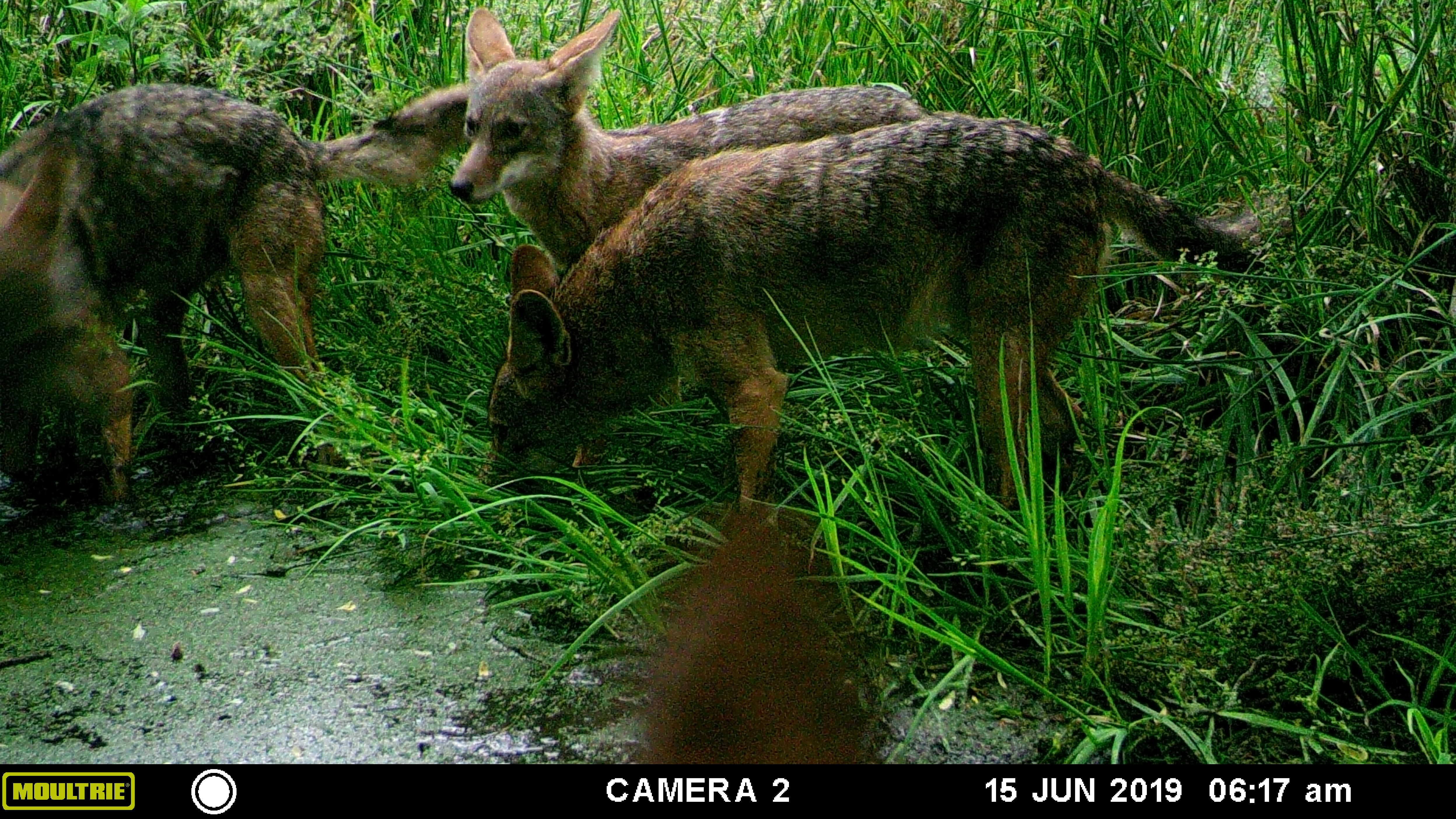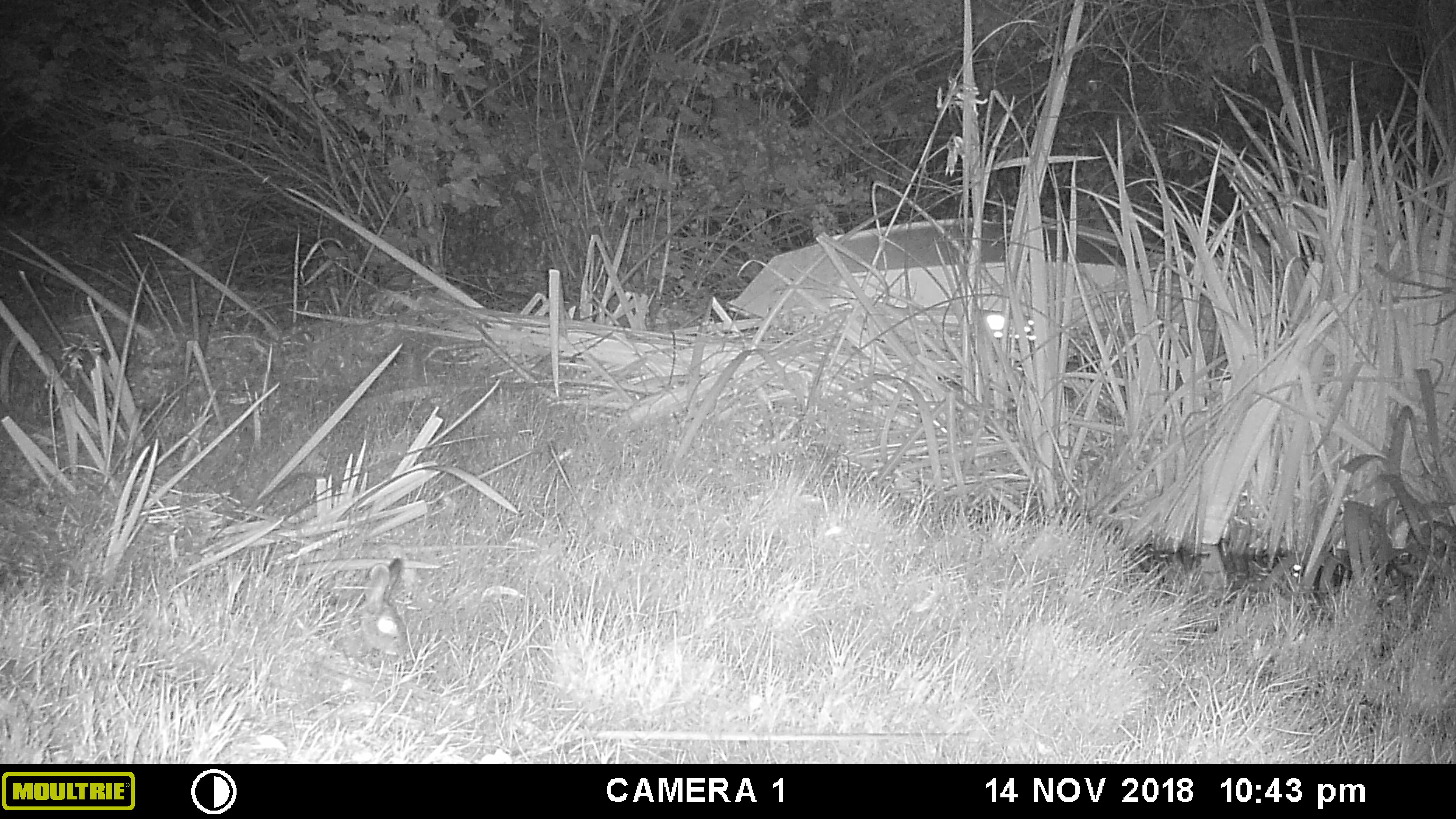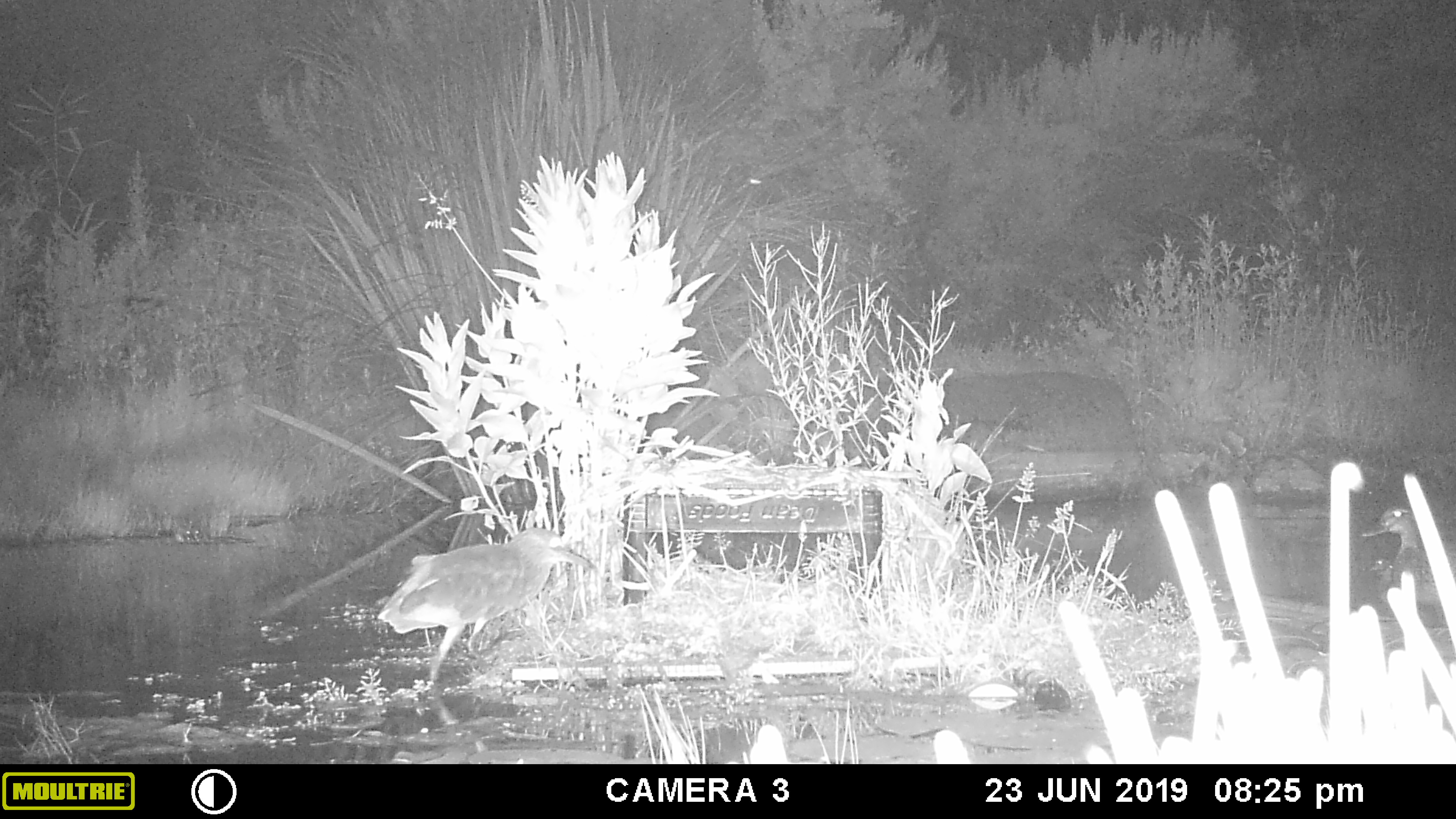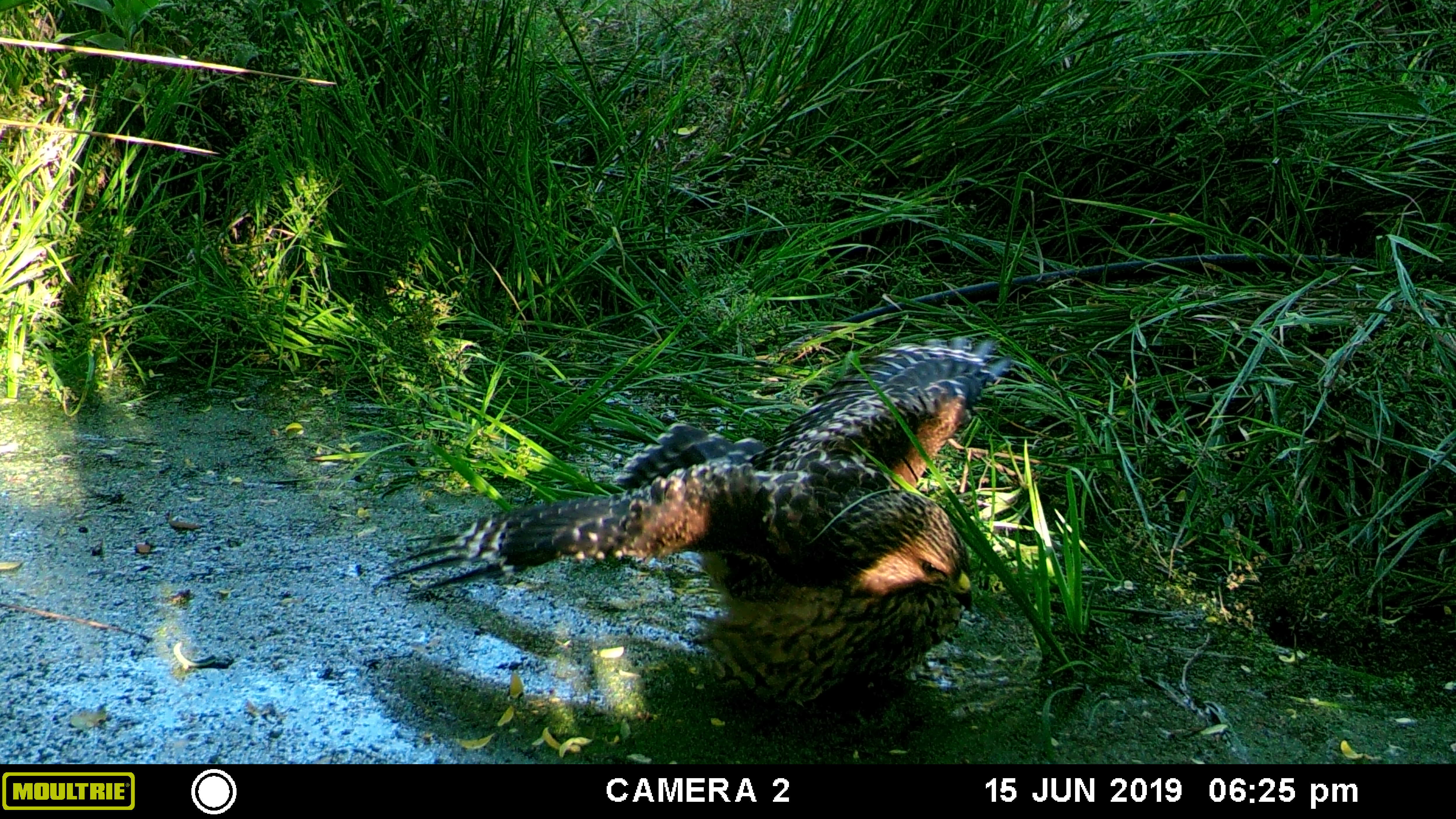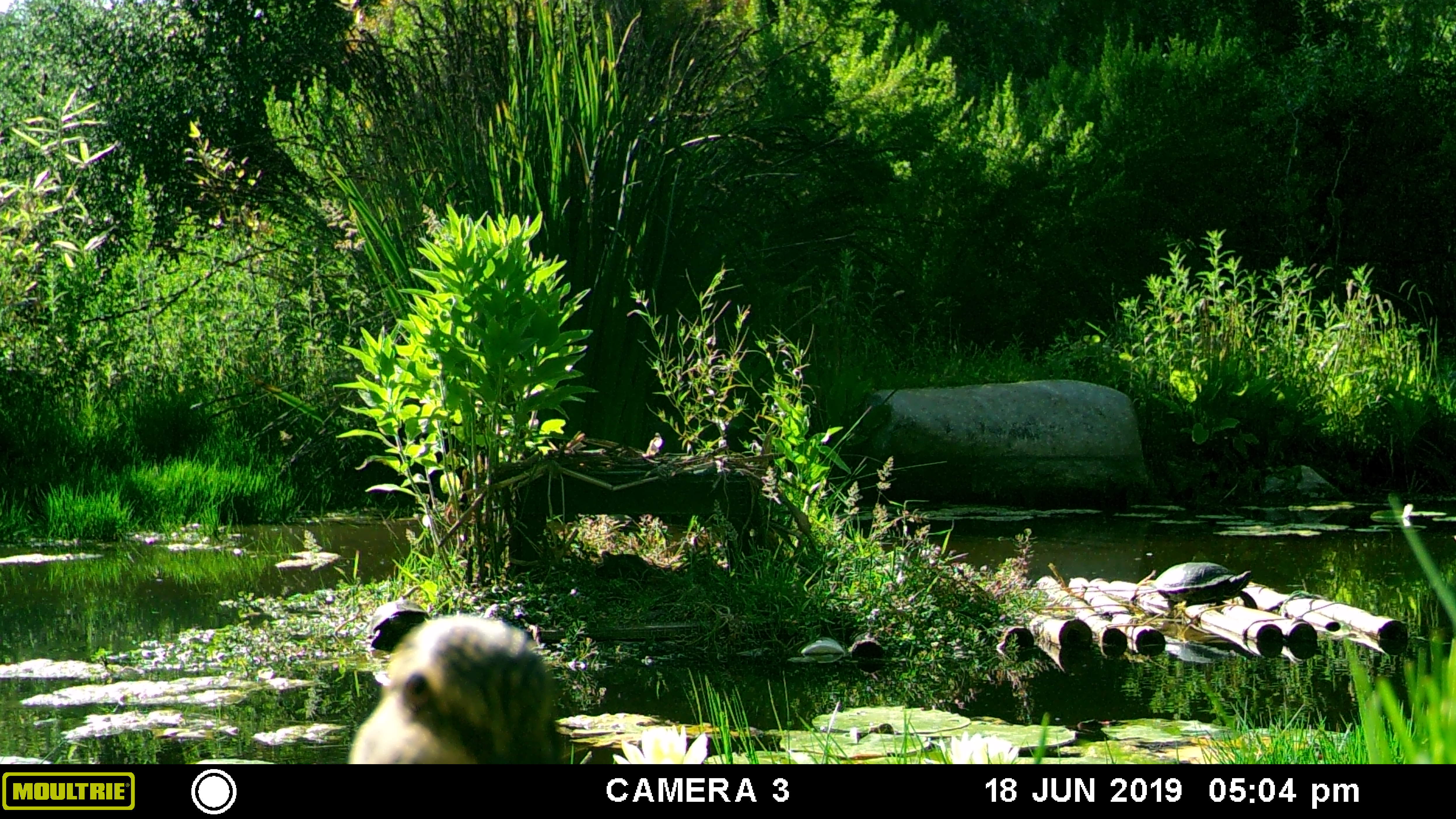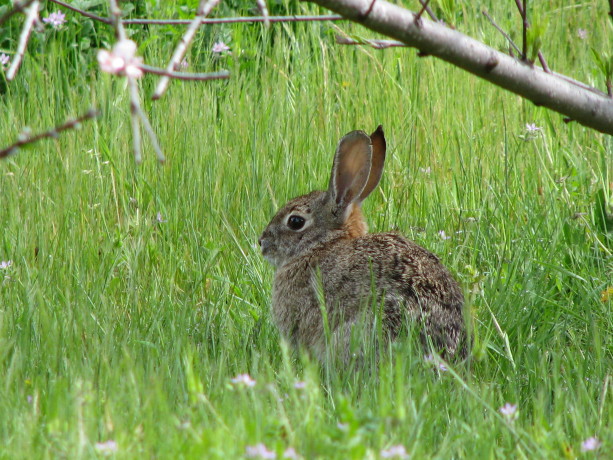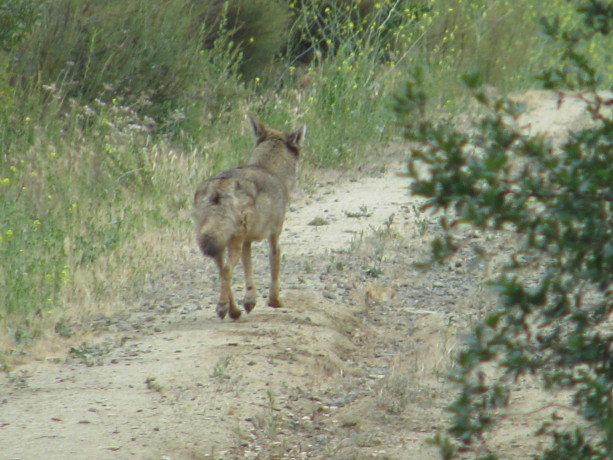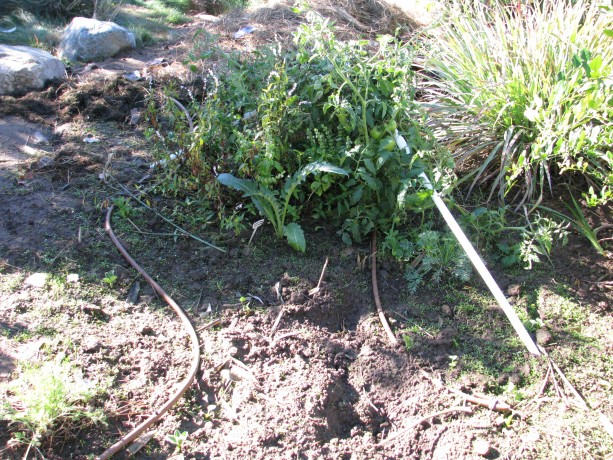-
Aphid Predators II
A WALK ON THE TINY SIDE

Remember this image of a sneaky syrphid fly larvae? Well, what I didn’t point out before was that there’s an even sneakier attendee at this aphid-nomming party. And she’s that little black line across the white leaf vein in the top middle of the photo: a parasitoid wasp.
Parasitoid wasps are pretty full-on — their simple life functions can include grotesqueries you thought only originated in the imaginations of sci-fi script writers. But they’re part of the complex web of ecological checks and balances in their systems.
The difference between parasitic and parasitoid is that a parasitic animal generally doesn’t kill or even directly seriously harm the host; it needs the host to continue functioning so that it can support the parasite. A parasitoid uses the host up in the process of supporting its own growth and/or reproduction.
That sneaky parasitoid lady and her cohort are the authors of the scene of destruction above. What look like little brown bumps on my Brussels sprouts leaf are in fact the corpses of aphids: the dried, hardened exoskeletons of used-up hosts. You can even see a small, round hole in the top of one — the door the exiting parasitoid punched out and left open behind it.
Parasitoid wasps like this one home in on the distinct chemicals released by the feeding and typical drama (like terror over a syrphid fly larva attack) of an aphid colony. Fertilized females settle on leaves and begin their prowl.
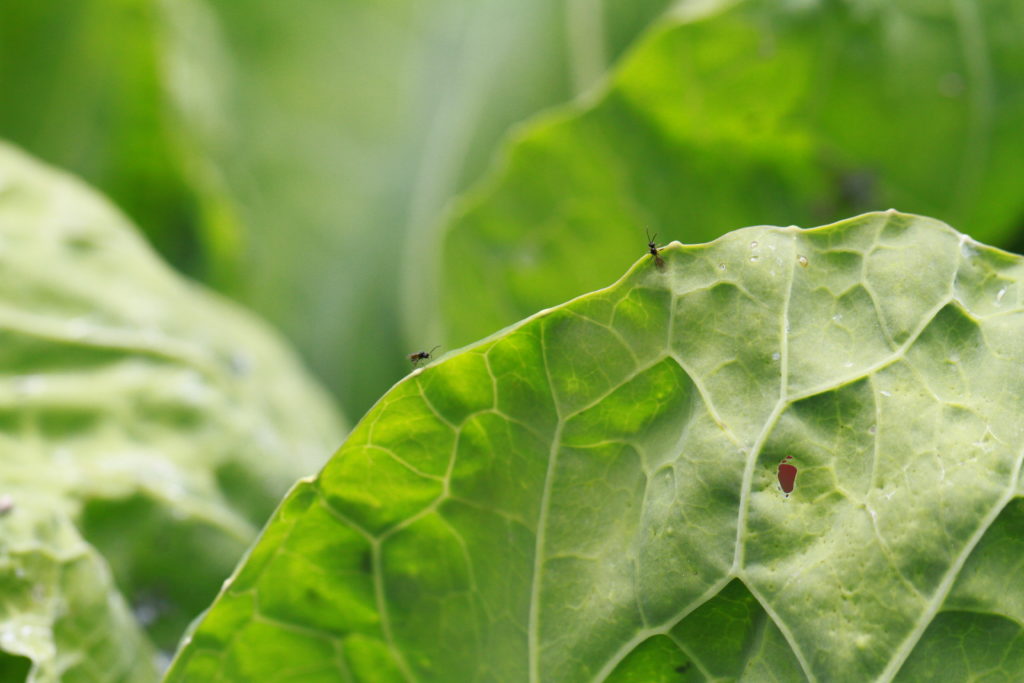
They’re looking for nice, juicy aphids that will be able to feed their grubs to adulthood. With a quick stab of her ovipositor, a female wasp injects a single egg into a chosen aphid, then prowls on. Once that tiny egg hatches, however, the aphid will slowly be hollowed out from the inside by the hungry, growing grub, until only a husk is left and the mature wasp breaks its way out, exercising its brand-new wings in flight for the first time.
The world is made up of opportunities being taken: everything is a resource and every resource is a chance for an existence to bloom. Sometimes, that existence is just really horrific. But it works for them and it works to create a functioning ecosystem — dynamic equilibrium — so we can all actually be very grateful for the parasitoid wasps.
Creeped out, but grateful. -
Aphid Predators
A WALK ON THE TINY SIDE
Another blooming colony of cabbage aphids (Brevicoryne brassicae) on my brave Brussels sprouts: a familiar sight, especially as the weather warms.
But wait — what’s that?
That! The green thing!

It may look a lot like a cabbage white butterfly (Pieris rapae) caterpillar, but it’s definitely not. Take a closer look and you’ll see that rather than a mouthful of sprout leaf, this little green guy is munching on aphid.
One of the most numerous, in terms of species, groups of animals on Earth are the flies, order Diptera. Like any large family, there are some gems, some bad apples, some neutrals — and of course, all that depends on your point of view. To aphids, larvae of some Syrphid flies (family Syrphidae) are stone cold bad-‘uns.
Also known as ‘flower flies’ and ‘hover flies’, these natty little fellows pull a lot of weight (each species in its own way) in both natural and altered ecosystems. Their secret is in their adaptable nature: they’re able to take to human-made environments, so are often some of the only native wildlife in housing developments.

The tellingly-named four–spotted aphid fly, Dioprosopa clavata. Most species in North America as adults mimic bees with yellow, black and striped uniforms and certainly rival and even surpass native bees in pollination services (bees are generally more sensitive in many ways and so are more often excluded or eliminated from habitats). They eat nectar and pollen, as bees do, thus the common name ‘flower fly’.

Flies’ eyes are very distinctive and always give away dipterid mimics passing as other insects — you can’t hide those flyin’ eyes, Copestylum avidum! And of course, most syrphid fly larvae are voracious predators of aphids, making them powerful elements of any garden’s pest management system (a.k.a. ecosystem). Be sure to make friends with yours! Get in touch with Pest Control Cincinnati

- Animals, Bees, Birding, Gardening adventures, Other Insects, Ponds, Predators, Quail, Reptiles and Amphibians
The Uninvited Guest: Living With Wildlife
The Uninvited Guest: Living With Wildlife
Finch Frolic Garden’s Program in the Garden Series
Sunday, May 24 2-4 pm
Miranda Kennedy (B.S. Fisheries and Wildlife Science) brings a naturalist’s enthusiasm and a scientist’s perspective to the topic of wildlife vs. domesticated land.
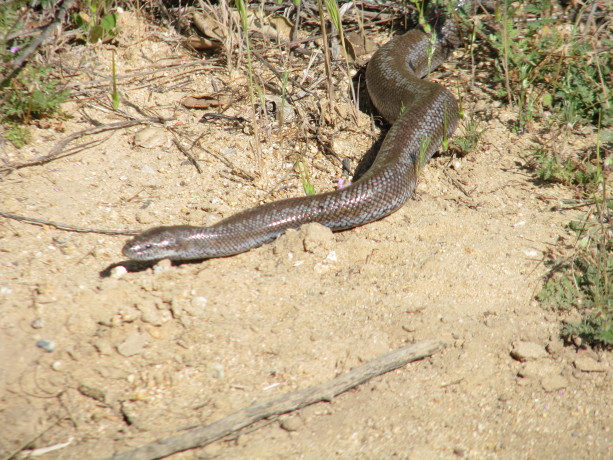 In this fun informal talk, Miranda will give insight into the ecology of many of our wonderful Southern California native wildlife species, focusing on the issues of the human-wildlife interface such as land management, garden damage, disease, domestic animals, pollinators, and the conservation concern. The talk and discussion will explore methods for peaceful and mutually beneficial cohabitation of this precious resource necessary to human and wildlife alike: habitat.
In this fun informal talk, Miranda will give insight into the ecology of many of our wonderful Southern California native wildlife species, focusing on the issues of the human-wildlife interface such as land management, garden damage, disease, domestic animals, pollinators, and the conservation concern. The talk and discussion will explore methods for peaceful and mutually beneficial cohabitation of this precious resource necessary to human and wildlife alike: habitat. Each attendee will receive a native pollinator-attracting plant! We will, of course, offer homemade vegetarian refreshments.
Cost is $25 per person. Finch Frolic Garden is located at 390 Vista del Indio, Fallbrook. Please RSVP to dianeckennedy@prodigy.net . More information can be found at www.vegetariat.com.
-
Coyotes
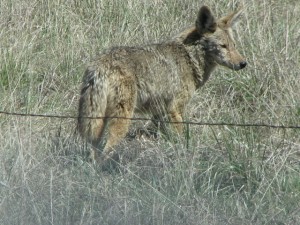
A coyote from some years back. Fall and winter are the times of year when many outdoor pets disappear. I’ve blogged on this before, too. ‘Teenaged’ coyotes, hungry (just like human teens!), bolder and less cautious will come closer to homes and people to grab food. If there is pet food outside the house, coyotes will take it if they can. If you have small pets outside, even chained, they can be killed by coyotes.
This doesn’t make coyotes evil. They are predators, a very necessary part of the food chain. Look up ‘trophic cascade’. That is how preditors in a wild environment cause prey animals to keep moving in natural patterns. Unthreatened, not only can prey animals reproduce to extremes, but also they will linger over feeding areas and eat plants down to the ground rather than trim them and move on.
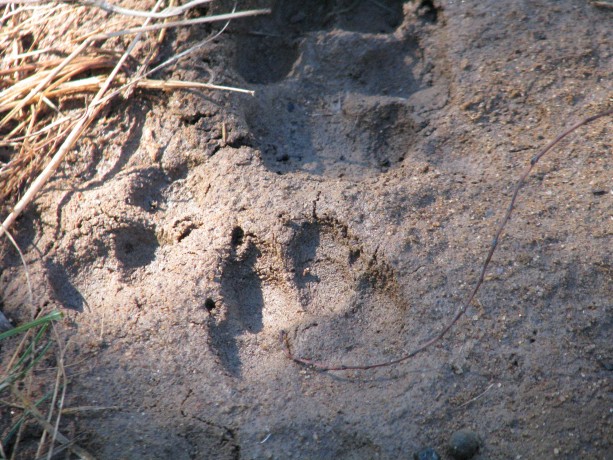
Coyote pawprints by the pond where they stopped for a drink. Dog pawprints have nails; cat (mountain lion!) pawprints don’t because their nails retract. Coyotes are intelligent, loyal, family-oriented, playful animals. They also make very scary sounds when howling and yipping in packs. Coyotes are no threat to humans unless the coyotes are sick, or if a child comes close when a coyote is eating outdoor pet food and is frightened.
Now that our last dog, Sophie, has passed away, coyotes are jumping the five-foot chainlink fence nightly and hunting in our yard. They have been unable to breach the Fowl Fortress (the hens are also locked into their coop within the FF for double protection). Unfortunately on Halloween I let the hens out of the coop about 45 minutes before dark. They had just gone under the Mock Pavilion, and I went into the FF to give Belle some of her special mash when there was a wild clucking. A coyote had come close and grabbed Chickpea our Americauna, and they were gone. My daughter saw it running away, and I dashed after, losing my slippers on the way, and hunted all over the neighbor’s yard but there was no sign of her.
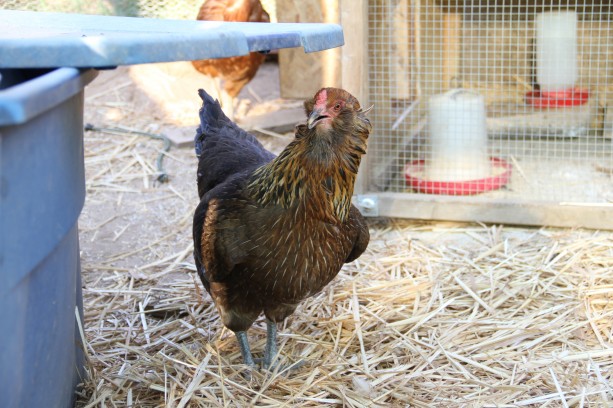
It was tramatizing, and I kick myself because I should have known better, even though I was just yards away and the hens had been released only minutes before. It was a lucky chance for the coyote, who must have already been in the yard but hidden by plants. At least it was a quick death for our darling Chickpea. It hurts us both that she is gone. No more ‘outies’ for the girls, even with a hensitter.
The coyotes leave scat in our yard and we can tell what they’ve been eating.
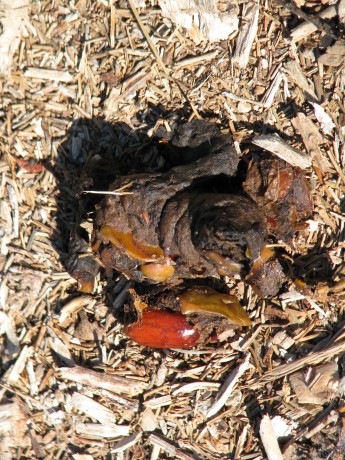
Sorry. Yes, it is coyote scat. Notice the seeds. Tiny seeds show that they were eating figs off of some volunteer fig trees down in the barranca. Larger seeds and skin in the scat shows that they are eating the red Eugenia berries in our yard. There is never much fur in the scat, so these omnivores have to scavenge to stay alive.
On the funny side, one day a few weeks ago I saw some fuzzy green thing in the yard.
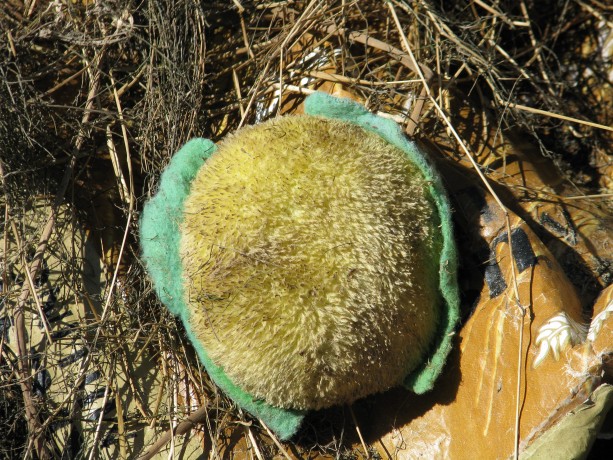
A coyote-delivered squeaky toy. It has since had its squeaker removed, and been slowly shredded by visiting coyotes. It turned out to be what looked like the center of a plush sunflower dog toy. It squeaked. It wasn’t ours. Some young coyote found it in another yard, carried it over the fence and played with it down by our pond. Over the next week it was moved around each night. One morning I found it next to a veggie bed I’d recently planted.
Then I realized that the rubber snake I put down in the bed to discourage birds was gone! My daughter and I looked everywhere for the snake, even for pieces of it, but it was gone! Some neighbor is going to have a real bad moment one of these days when walking through their property and they come across my rubber snake.
-
Keep In Your Pets: It is Predator Season
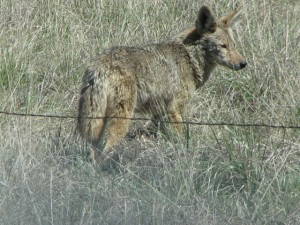
This juvenile coyote was playing with his litter mate at the Santa Rosa Preserve in plain site of the road. Youth just aren’t cautious, no matter what species. Photo by Miranda Kennedy We are entering the time of year when outdoor cats, small dogs, free-range chickens and any small pet go missing. Pre-adult (aka teenage) coyotes from this year’s early litters are just as hungry and just as fearless as human teens, and they are looking to fill growling stomachs during the day and night. (Besides, a study by University of Nebraska found that feral cats are responsible for the extinction of 33 species of birds worldwide. Keep your cats contained!) Can’t blame coyotes because this is their land. Preditors are an important part of our ecosystems and the removal of them have devastating effects on our ecosystems, all the way down to the plants in a process called trophic cascade. During this heat wave I’ve been sleeping with windows open. At about 5:15 am I heard the hens going crazy down in their Fowl Fortress . Throwing on my white robe and slippers I ran down the hill towards the coop. Just before I reached it, a young handsome coyote came around the corner behind the compost bins and we nearly collided. He was across the property and over the chain link fence in a heartbeat. The hens were safe because the Fortress is wired up both sides and across the top, and the wire goes into the dirt. However if the coyote were to have time to dig he could have been inside. The hens were so upset that they didn’t lay right for several days. Miss Amelia, the leader, was on top of the chicken tractor screeching away. Chickpea and even formidably-built Lark were on top of the smaller coop. These three survived the coyote attack that killed two of their friends last winter (pre-Fowl Fortress). The two adopted Rhode Island Reds were standing by the door wondering what all the fuss was about; they’ve seen our two elderly, partially deaf and blind dogs walk past all the time. General Mischief, whose probably only working park is his sniffer, lumbered excitedly around the property following the coyote’s path. At night I began to lock the hens inside the chicken tractor where they roost inside the Fortress, so that they’d have two lines of defense.
The next morning I arose to chicken screeching even earlier, and ran down there to see a coyote coming from around the back of the Fortress. I knew where it would jump the fence so I ran in that direction, which gave it quite a surprise as it had to pass me to get there. I stood at the fenceline brandishing a rake that I had caught up on the way down the hill, dressed in slippers and long white robe, shouting threats into the neighbor’s backyard like a lunitic. One thing about growing older is that eccentric behavior is excused.
I wasn’t about to let the coyotes believe they could hunt within my fence. The next morning I was up and out just after five, me and General, my rake and my white robe, over which I’d pulled a red jacket because the morning was misty. I stood at the fenceline, pulling some ragweed to not waste time. In about five minutes I felt that they were coming and stood waiting. Sure enough, halfway across the neighbor’s property were some bushes and from around behind them trotted a coyote. He looked pretty jaunty and sure of himself until he turned and caught an eyeful of me. I shook my rake and he seemed to shake his head disbelievingly. Then he cut out the way he had come. Victory for me!
I collected dog poo and dumped it along the fenceline, and stuck clumps of fur left from shaving General’s thick coat into the top holes in the fence. I love the country life.
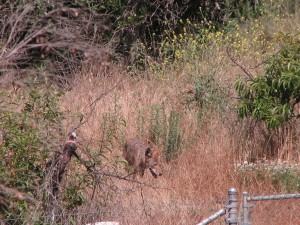
Of course I didn’t bring a camera on my morning patrols. This coyote was in what is now the Bee Garden, several years ago. He looks worse for wear. Photo by Miranda Kennedy. For the next few mornings I’d roll out of bed, motivate Sophie and General to get up and go outside, and I’d patrol the fence and make my presence known at the entry point. Although I was sleep-deprived (with the late darkness I tend to only get dinner at about 9 and to bed by 11) I managed to to get some impressive gardening done, especially since I changed into old clothes before heading out. There was no more coyote activity, at least none that the hens told me about.
The other night the pack was running down in the streambed and were yipping and howling in communication. I think it was just past midnight, but I went out there just to make sure there were no visitors.
Sophie is a 14 year old rescued pit bull mix I’ve had since she was about a year old. I knew that she had run with coyotes as a youngster when her owner let her loose, and I never understood why she hadn’t been attacked. Her back legs don’t work well, and she’s feeling her age. She used to climb the chain link fence and roam the neighborhood. She used to kill cats, chase rabbits, keep the mice and rats out of the garage where they used to sleep. For the last few years it has been all peace and love with Sophie. She not only seems to be afraid of some of the cats in the house, but would walk past the ranging hens without putting any of her thoughts into action. I once went to wake her up when she was still sleeping outside, and a mouse ran out from under her. I’d disturbed its warm cozy sleep.
So this morning I let out the dogs when General woke me up and tried to go back to bed. It never works because when General is done he rakes the metal security door with his nails until I let him in again. Sure enough, in about five minutes he was demanding attention again so I put on my robe and went out to do the hens. I was just past the driveway when I caught sight of Sophie on one of the garden paths close to the house. She had a friend with her. A coyote. Sophie was just turning away from it to walk back to the house and the coyote was looking around at the bushes, hopeful for a rabbit breakfast until it saw me and scooted away. The fur was raised a little on Sophie’s back, but not all the way. I made sure he was clear of the property, and checked the hens who were still double locked in. Then I had a few words with Sophie about the choice of friends she asked over!
